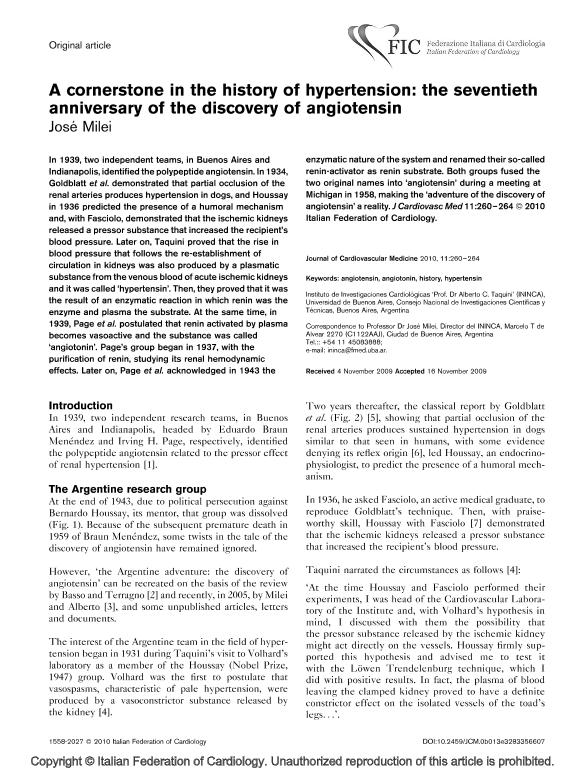Artículo
A cornerstone in the history of hypertension: The seventieth anniversary of the discovery of angiotensin
Fecha de publicación:
04/2010
Editorial:
Lippincott Williams
Revista:
Journal Of Cardiovascular Medicine
ISSN:
1558-2027
Idioma:
Inglés
Tipo de recurso:
Artículo publicado
Clasificación temática:
Resumen
In 1939, two independent teams, in Buenos Aires and Indianapolis, identified the polypeptide angiotensin. In 1934, Goldblatt et al. demonstrated that partial occlusion of the renal arteries produces hypertension in dogs, and Houssay in 1936 predicted the presence of a humoral mechanism and, with Fasciolo, demonstrated that the ischemic kidneys released a pressor substance that increased the recipient's blood pressure. Later on, Taquini proved that the rise in blood pressure that follows the re-establishment of circulation in kidneys was also produced by a plasmatic substance from the venous blood of acute ischemic kidneys and it was called 'hypertensin'. Then, they proved that it was the result of an enzymatic reaction in which renin was the enzyme and plasma the substrate. At the same time, in 1939, Page et al. postulated that renin activated by plasma becomes vasoactive and the substance was called 'angiotonin'. Page's group began in 1937, with the purification of renin, studying its renal hemodynamic effects. Later on, Page et al. acknowledged in 1943 the enzymatic nature of the system and renamed their so-called renin-activator as renin substrate. Both groups fused the two original names into 'angiotensin' during a meeting at Michigan in 1958, making the 'adventure of the discovery of angiotensin' a reality. © 2010 Italian Federation of Cardiology.
Palabras clave:
Angiotensin
,
Angiotonin
,
History
,
Hypertensin
Archivos asociados
Licencia
Identificadores
Colecciones
Articulos(ININCA)
Articulos de INST.DE INVEST.CARDIOLOGICAS (I)
Articulos de INST.DE INVEST.CARDIOLOGICAS (I)
Citación
Milei, Jose; A cornerstone in the history of hypertension: The seventieth anniversary of the discovery of angiotensin; Lippincott Williams; Journal Of Cardiovascular Medicine; 11; 4; 4-2010; 260-264
Compartir
Altmétricas




